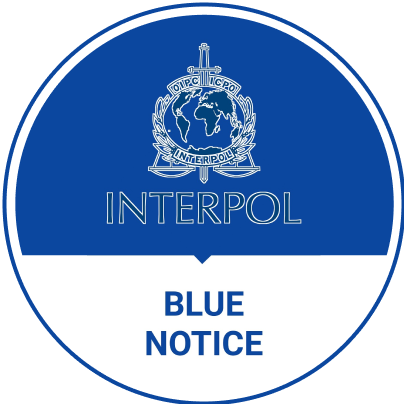How is an Interpol Blue Notice issued?
The CCF is an independent body of Interpol, whose main purpose is to oversee the processing of personal data. It acts as a kind of arbitrator, ensuring the rights of individuals about whom Interpol holds information are respected. The CCF can make decisions on whether to retain, amend, or delete blue notices.
The Commission for the Control of Interpol’s Files is responsible for receiving requests for notices from the National Central Bureaus of Interpol member states. The CCF also checks blue notices to ensure they fully comply with legal requirements. Only after this are the requests entered into Interpol’s database.
First off, Interpol doesn’t accept any requests that have a military, religious, political, or racial bias. Secondly, Interpol’s notices can’t violate human rights. That’s what Article 2 of the Constitution says. The last mandatory requirement is that the notice must contain enough information about the person under suspicion or being sought after.
Let’s take a closer look at the procedure for issuing an Interpol Blue Notice:
- Engaging an organization. The process of issuing a blue notice begins at the initiative of national law enforcement agencies working on a specific criminal investigation. Typically, agencies such as the police, customs, or immigration services identify a need to gather additional information about an individual that may be important for the investigation. To do this, they reach out to the Interpol National Central Bureau (NCB), which is located in each member country.
- Submitting a Request. Law enforcement agencies submit a request to the INTERPOL National Central Bureau for the issuance of a Blue Notice. The request must clearly state the purpose of the notice, as well as provide all necessary information about the individual in question (name, photographs, fingerprints, last known location, and other identifying details).
- Compliance Check. For a blue notice request to be accepted by Interpol, it must meet certain criteria. Specifically, the notice must pertain to an individual who is significant to an investigation. It’s crucial that the request is justified and based on factual information. Interpol reviews the request to ensure it complies with international law requirements and does not violate Interpol’s principles, particularly the principle of political neutrality.
- Issuing a blue notice. After reviewing the request, Interpol issues a blue notice, which is distributed to all member countries through a specialized system. This message becomes available to law enforcement agencies, which can assist in gathering the necessary information.
After issuing a blue notice, law enforcement agencies of the member countries begin gathering information, which will later be forwarded to Interpol. The data collected can be used for further investigation.
Comparing Interpol’s Red Notice and Blue Notice
A Red Notice is issued to seek the location, arrest, and subsequent extradition of an individual. Its issuance comes at the request of a member country, not Interpol itself. A Red Notice is used to alert law enforcement agencies and contains personal information, details about the crimes, and in some cases, a national arrest warrant. However, Interpol is not obligated to issue a Red Notice simply because a member state requests it.
An Interpol Blue Notice is issued to collect additional information about individuals of interest. Upon request, law enforcement agencies can receive information about the movements of suspects or witnesses. However, a Blue Notice cannot include a call for arrest. It also does not serve as an international arrest warrant.
So, the main difference between Interpol notices is that blue notices are not used to arrest suspects, but exclusively for gathering additional information.
If you need advice regarding Interpol notices, our law firm has the necessary experience to provide professional support. Contact us to get expert help and protect your rights. law firm specializing in the removal of Interpol Red Notices can help protect your rights. Reach out to us for professional consultation and legal support.
Is it possible to remove an Interpol Blue Notice?
As mentioned before, an Interpol Blue Notice doesn’t automatically lead to an arrest. However, individuals under suspicion might find themselves under unwanted surveillance or monitoring. This raises the question: Is it possible to remove an Interpol Blue Notice?
First off, you need to accurately determine if a blue notice has been issued in your name. Qualified and experienced Interpol lawyers can do this by submitting a request for information to the relevant authorities.
After receiving a positive response, it’s crucial to conduct a comprehensive analysis of the specific situation, assess the legality and justification of the notification. After gathering all necessary evidence and documents to prove your innocence or the illegitimacy of the notification, lawyers will prepare an official request to the Interpol Files Control Commission.
Let’s look at the most common legal avenues for appealing or removing a blue notice:
- Request to the CCF. The Interpol Files Control Commission reviews requests for the deletion and appeal of notices. An individual against whom a blue notice has been issued can submit a request to the CCF arguing that this notice is unlawful, violates their rights, or is unjustified.
- Contesting the grounds for issuance. To successfully remove a blue notice, it’s necessary to provide clear evidence that the notice was issued in violation of Interpol’s rules or international law. If the notice was issued based on information that turned out to be false or unreliable, this could also be grounds for its removal.
Consulting with an experienced attorney on Interpol matters is a crucial step for successfully removing a blue notice. An attorney can help gather the necessary evidence, prepare a well-founded request to the CCF, and defend your rights during the case review. Additionally, a legal expert can offer advice on potential risks and consequences associated with challenging a blue notice.
How can our Interpol lawyers help you?
Our qualified lawyers specialize in assisting clients with any questions regarding Interpol notices. Experienced professionals will help determine if there is an Interpol blue notice issued in your name, as well as evaluate the legality and justification of the request.
After a comprehensive analysis, our lawyers will develop a personalized strategy to protect our clients’ rights and interests. We’ll prepare all the necessary documents and evidence to contest an Interpol notice, and we’ll also represent your interests when interacting with the CCF and other relevant authorities.
When you turn to our law firm, you can be confident that your case is in good hands. We’ll do everything we can to clear the blue message and protect you from any further legal consequences. Don’t wait—contact us today to discuss your situation and start the process of defending your rights.



